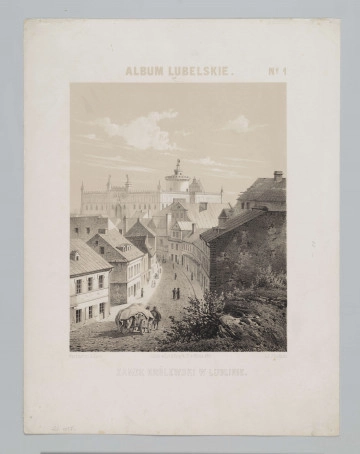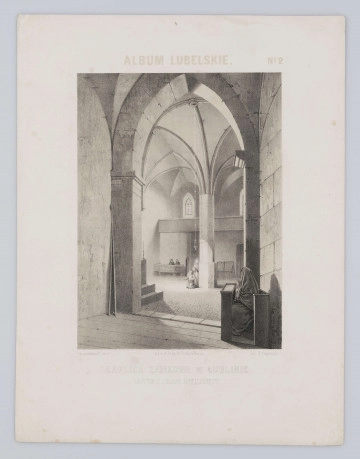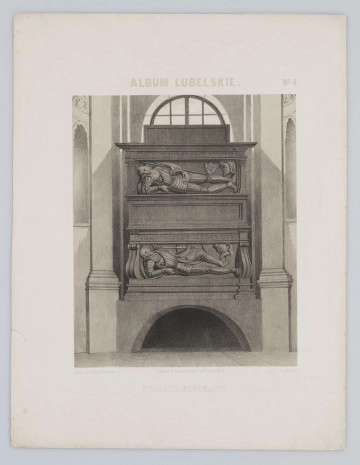
Royal Castle in Lublin
1857
National Museum in Lublin
Part of the collection: Lubliniana. Painting views of Lublin and the Lublin Region
The Gothic-Renaissance Church of the Assumption of the Blessed Virgin Mary the Victorious (now the rector’s church), known as the post-Bridgettine, post-Visitandines or Grunwald church, is an important building for the history of Poland and Lublin. It is one of the earliest and most beautiful religious buildings in the Lublin region. It is the oldest St. Mary’s Church in Lublin and one of the first to be established in Poland. Together with the monastery, it was founded by Władysław Jagiełło as a votive offering in gratitude for the victory over the Teutonic Order at Grunwald on July 15th, 1410. It is the first monument in the country to commemorate it. It was built in the years 1412-1426 outside the city walls, on the route to Krakow, in place of the previously existing (before 1396) chapel of the Blessed Virgin Mary for the sisters and brothers of the order of St. Brigid of Sweden, who many years earlier in her apparitions foretold the victory of the monarch over the Teutonic Knights. Teutonic prisoners of war, who lived in a village named after their nationality as Niemce, near Lublin, worked on the construction of the church. The Gothic church, despite the reconstruction in the second half of the 16th century and the first half of the 17th century, largely retained the features of medieval architecture, including the remains of late Gothic polychrome in the aisle and in the attic. It is distinguished by the asymmetrical division of the interior into two aisles made around 1480, the tower-belfry added to the façade line (built in the first half of the 16th century, augmented at the end of the 16th or at the beginning of the 17th century) and a characteristic stepped gable (shaped after 1586). It includes, among others, high-class stucco decorations in the type of the so-called Lublin Renaissance from the second quarter of the 17th century and valuable furnishings (a picture cycle from the life of St. Bridget from 1632-1660 decorating stalls) and a set of neo-Gothic altars from 1903. A wooden crucifix, probably at the turn of the 15th and 16th centuries, measuring about 190 cm, was placed on the wall in the side nave (until 2013 on the chancel arch, earlier perhaps in the porch), and it is considered to be the oldest figure of the crucified Christ in Lublin. It was a witness to history, among others, of oppositionists praying by it during the times of ‘Solidarity’ (1980s).
After the dissolution of the Bridgettine Convent in 1818, in 1835 the buildings were handed over to Lublin Visitation Sisters who left Lublin in 1882. Then, government institutions were placed in the monastery building. In 1917, the Ursuline Sisters came to live here, and they regained the monastery in the 1990s.
Renata Bartnik
Author / creator
Dimensions
cały obiekt: height: 21,6 cm, width: 17,8 cm
Object type
graphics
Technique
lithography
Material
paper
Creation time / dating
Creation / finding place
Owner
The National Museum in Lublin
Identification number
Location / status

Cegliński, Julian
1857
National Museum in Lublin

Cegliński, Julian
1857
National Museum in Lublin

Cegliński, Julian
1857
National Museum in Lublin
DISCOVER this TOPIC
National Museum in Szczecin
DISCOVER this PATH
Educational path
0/500

We use cookies to make it easier for you to use our website and for statistical purposes. You can manage cookies by changing the settings of your web browser. More information in the Privacy Policy.
We use cookies to make it easier for you to use our website and for statistical purposes. You can manage cookies by changing the settings of your web browser. More information in the Privacy Policy.
Manage cookies:
This type of cookies is necessary for the website to function. You can change your browser settings to block them, but then the website will not work properly.
WYMAGANE
They are used to measure user engagement and generate statistics about the website to better understand how it is used. If you block this type of cookies, we will not be able to collect information about the use of the website and we will not be able to monitor its performance.